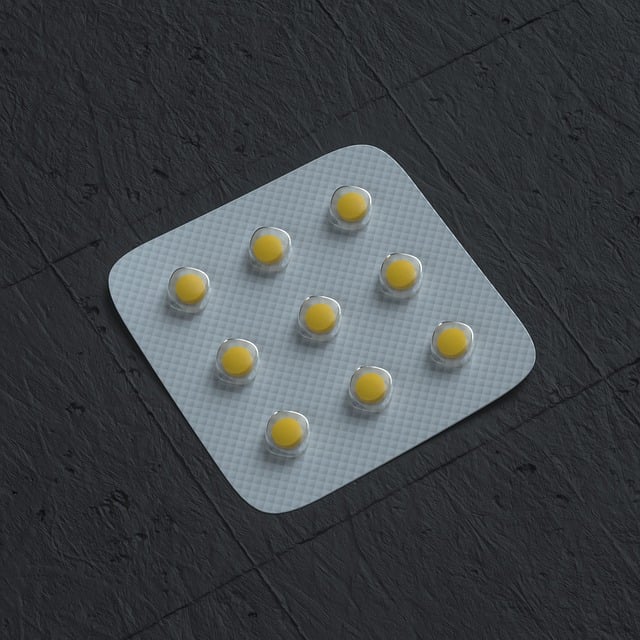Semaglutide, a revolutionary GLP-1 receptor agonist, transforms type 2 diabetes management by mimicking natural gut hormones. Its dual mechanism enhances insulin secretion, suppresses glucagon release, and promotes satiety, leading to improved blood sugar control and reduced HbA1c levels. Clinical trials validate its efficacy, positioning it as a safe, sustainable, and potentially long-term diabetes treatment with cardiovascular benefits. With weekly subcutaneous injections, semaglutide boosts energy, overall health, and well-being, while ongoing research explores its broader impact on metabolic disorders and administration innovations.
“Discover the transformative power of semaglutide, a groundbreaking glucagon-like peptide-1 (GLP-1) receptor agonist, in managing type 2 diabetes. This article explores Semaglutide’s pivotal role in reducing HbA1c levels, offering a comprehensive guide to its mechanism of action, clinical efficacy, and real-world benefits. From understanding its unique properties to navigating administration and considering potential side effects, we delve into the latest research, patient success stories, and future prospects, highlighting Semaglutide’s promise as a game-changer in diabetes treatment.”
Understanding Semaglutide: A Glucagon-Like Peptide-1 Receptor Agonist

Semaglutide is a groundbreaking medication that plays a significant role in the management of type 2 diabetes. It operates as a Glucagon-Like Peptide-1 (GLP-1) receptor agonist, mimicking the natural hormone GLP-1, which is produced in the gut after eating. This imitation has profound effects on blood sugar control. By activating specific receptors, semaglutide stimulates insulin secretion when blood sugar levels are high, helping to lower glucose. Moreover, it suppresses glucagon release, a hormone that raises blood sugar.
In the context of diabetes treatment, semaglutide has proven highly effective in reducing HbA1c (hemoglobin A1c) levels—a key indicator of long-term blood sugar control. Its ability to improve glycemic management has made it a preferred choice for many patients and healthcare providers. As a semaglutide diabetes treatment, it offers a safe and sustainable approach to managing the condition, potentially reducing the risk of diabetic complications over time.
The Impact of Semaglutide on Blood Sugar Regulation

Semaglutide, a novel glucose-dependent insulinotropic polypeptide (GIP) receptor agonist, has emerged as a powerful tool in the management of type 2 diabetes. Its primary mechanism of action involves enhancing insulin secretion in a glucose-dependent manner, suppressing glucagon release, and promoting satiety, leading to improved blood sugar regulation. This multi-faceted approach significantly reduces HbA1c levels, providing a much-needed solution for many patients struggling with this chronic condition.
In the context of semaglutide diabetes treatment, clinical trials have demonstrated its efficacy in lowering blood glucose concentrations and improving overall metabolic control. By mimicking the natural effects of GIP, semaglutide helps restore the body’s natural balance, making it a game-changer in the way we approach type 2 diabetes. This innovative therapy offers hope for better glycemic control, weight management, and potential cardiovascular benefits, all without the complexities often associated with traditional insulin therapies.
Mechanism of Action: How Semaglutide Reduces HbA1c

Semaglutide, a glucose-dependent insulinotropic polypeptide (GIP) receptor agonist, plays a pivotal role in managing type 2 diabetes through its unique mechanism of action. Its primary effect is to stimulate insulin secretion from pancreatic beta cells in a glucose-dependent manner, ensuring a balanced response that prevents both hyperglycemia and hypoglycemia. This targeted approach makes semaglutide an effective diabetes treatment option.
By mimicking the natural hormone GIP, semaglutide promotes satiety, leading to reduced food intake and decreased blood sugar levels. It also slows gastric emptying, allowing for a more sustained release of insulin and better glucose control. This dual action not only helps in reducing HbA1c (hemoglobin A1c) levels but also improves overall metabolic health, offering a comprehensive solution for managing diabetes.
Clinical Trials and Their Findings on Semaglutide's Efficacy

Clinical trials have played a pivotal role in unraveling Semaglutide’s potential as a revolutionary semaglutide diabetes treatment. These rigorously controlled studies have provided robust evidence for its efficacy in managing type 2 diabetes, with a particular focus on lowering HbA1c levels. In numerous clinical trials, Semaglutide has demonstrated remarkable results, showing significant reductions in blood sugar levels and improving overall glycemic control.
The findings consistently highlight Semaglutide’s ability to enhance insulin secretion, inhibit glucagon release, and promote weight loss—all contributing factors in achieving better metabolic outcomes. These trials have not only solidified Semaglutide’s position as a potent medication but also opened new avenues for diabetes management, offering hope for improved quality of life for individuals living with this chronic condition.
Benefits of Semaglutide in Type 2 Diabetes Management

Semaglutide, a novel glucagon-like peptide-1 (GLP-1) receptor agonist, has emerged as a powerful tool in the management of Type 2 diabetes. Its primary benefit lies in its ability to significantly reduce blood glucose levels, making it an attractive option for diabetes treatment. This medication mimics the natural hormones produced by the gut, stimulating insulin secretion when blood sugar is high and suppressing glucagon release, which helps lower glucose levels.
In clinical trials, semaglutide has demonstrated exceptional efficacy in lowering HbA1c (a marker of long-term blood glucose control) by up to 1.5% compared to placebo, with some studies showing even greater improvements. Furthermore, its once-weekly administration makes it convenient for patients, potentially improving medication adherence and quality of life. The benefits of semaglutide extend beyond glycemic control; it has also been shown to reduce the risk of cardiovascular events, making it a versatile and effective diabetes treatment option with potential heart health advantages.
Side Effects and Consideration for Safe Usage

Semaglutide, as a powerful diabetes treatment option, offers significant benefits in reducing HbA1c levels. However, like any medication, it comes with potential side effects that should not be overlooked. Common adverse reactions include gastrointestinal issues such as nausea, vomiting, and diarrhea, which are often most pronounced during the initial stages of treatment. These symptoms usually subside as the body adjusts to the drug. More severe but rare side effects may include pancreatitis, kidney problems, or thyroid cancer, emphasizing the need for regular medical monitoring.
To ensure safe usage, it’s crucial to follow prescribed dosing instructions and maintain open communication with healthcare providers. Patients should report any unusual symptoms promptly. Additionally, semaglutide interactions with other medications and underlying health conditions must be considered. Careful management of these factors can help maximize the therapeutic benefits of semaglutide while minimizing risks, making it a more effective tool in managing diabetes.
Semaglutide Administration: Injection and Dosage

Semaglutide, a glucagon-like peptide-1 (GLP-1) receptor agonist, is administered via subcutaneous injection. This method allows for steady absorption into the bloodstream, enabling its effects on blood sugar regulation. The dosage typically starts at 0.5 mg weekly and can be increased to 2.4 mg weekly based on individual patient needs and response. It’s important to note that patients should receive their injections at the same time each week to maintain consistency in therapy.
The injection is usually given in the abdomen, thigh, or upper arm. It’s crucial for patients to rotate the injection site to prevent skin irritation or lipohypertrophy (uneven fat distribution under the skin). Patients should also be educated on proper needle handling and disposal techniques to ensure safety and adherence to their treatment plan.
Real-World Success Stories: Patient Testimonials

Many patients with type 2 diabetes have found success in managing their condition through real-world use of semaglutide, a groundbreaking diabetes treatment. Semaglutide, when administered via injection, has shown remarkable results in lowering HbA1c levels—a key indicator of long-term blood sugar control. Patient testimonials highlight the positive impact this medication has had on their lives.
These stories often speak to improved energy levels, better overall health, and a newfound sense of well-being. Many patients report easier management of their diabetes, reduced reliance on other medications, and even weight loss—benefits that extend beyond just blood sugar control. Such success stories serve as powerful evidence of semaglutide’s effectiveness in enhancing the quality of life for individuals living with type 2 diabetes.
Future Perspectives and Research on Semaglutide's Role in Diabetes Treatment

The future of semaglutide in diabetes treatment looks promising, with ongoing research exploring its potential beyond HbA1c reduction. Studies are delving into its impact on cardiovascular health, offering insights that could significantly influence clinical practice. Additionally, investigations into semaglutide’s mode of action and its effects on various metabolic pathways may unlock new strategies for managing not only type 2 diabetes but also other metabolic disorders.
As technology advances, there is potential for the development of more user-friendly administration methods, such as oral formulations or even sustained-release systems, enhancing patient compliance and convenience. Furthermore, combining semaglutide with other therapeutic agents could lead to synergistic effects, providing more comprehensive diabetes management solutions. These ongoing efforts aim to refine our understanding of semaglutide’s role in diabetes treatment, ultimately improving patient outcomes and quality of life.
